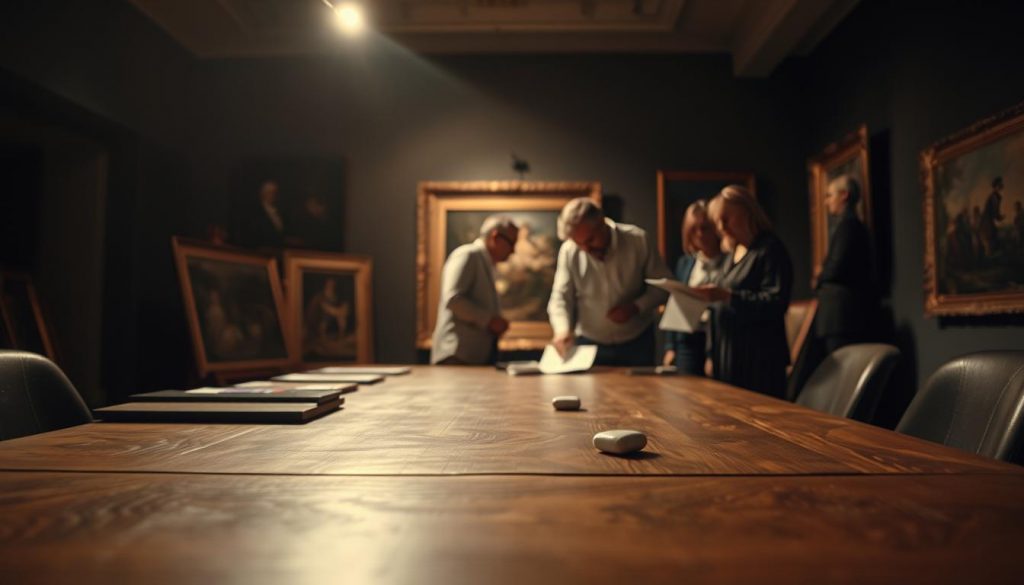We understand that building an art collection is a lifelong endeavour, and deciding its future can be a daunting task.
When considering the devolution of your estate, UK tax incentives can play a significant role in ensuring your collection is passed to future generations in a tax-efficient manner.
Moreover, gifting cultural property to museums can provide the nation with important works of cultural significance while benefiting from available tax reliefs.
As experienced professionals, we guide you through the process, making it easier to make informed decisions about your legacy.
Key Takeaways
- Gifting art to museums can offer significant tax benefits.
- UK tax incentives facilitate the passing of art collections to future generations.
- Cultural property donations can provide the nation with valuable works of art.
- Tax reliefs are available for donations made to museums.
- Professional guidance is essential for navigating the tax implications.
Understanding Inheritance Tax in the UK
The UK’s Inheritance Tax regime can be complex, but it’s essential for anyone with significant assets, including art and collectibles, to grasp its implications. Inheritance Tax is a tax on the estate of someone who has passed away, including all their assets, savings, and property.

What is Inheritance Tax?
Inheritance Tax is levied on the estate of the deceased before it is distributed to the beneficiaries. The standard rate of Inheritance Tax is 40% on the value of the estate above the nil-rate band, which is currently set at £325,000. However, there are several exemptions and reliefs that can reduce this tax liability.
Who is liable for Inheritance Tax?
Inheritance Tax is typically paid by the executors of the deceased’s estate. These individuals are responsible for managing the estate, including valuing assets, paying debts, and distributing the remaining assets according to the will or the rules of intestacy. The executors must also file an Inheritance Tax return and pay any tax due within 12 months of the date of death.
Key exemptions and reliefs
There are several key exemptions and reliefs available that can reduce the Inheritance Tax liability, particularly relevant to art and collectibles:
- Acceptance in Lieu scheme: Allows the transfer of significant cultural assets to public ownership in lieu of Inheritance Tax.
- Cultural Gifts Scheme: Offers tax relief to donors who give pre-eminent cultural objects to designated bodies.
- Conditional Exemption: Exempts certain heritage assets from Inheritance Tax if they are designated as being of national, scientific, or historic interest.
- Gifts for National Purposes: Provides relief for gifts made to certain institutions, such as museums and galleries.
For more detailed information on how these schemes can benefit art collectors, you can visit our article on Capital Gains and Inheritance Tax for Art.
Understanding these exemptions and reliefs is crucial for effective estate planning, especially for those with valuable art collections or cultural items. By leveraging these schemes, individuals can reduce their Inheritance Tax liability and ensure that their assets are preserved for future generations.
Art Donations and Tax Benefits
Art donations to museums and charities not only enrich cultural heritage but also offer attractive tax benefits. In the UK, the tax system is designed to encourage charitable giving by providing various reliefs and exemptions.

Overview of tax relief for art donations
Donating art to charity can provide significant tax relief. Gifts of art and other objects to charities are generally free from Inheritance Tax and Capital Gains Tax, regardless of whether the item is considered to be of pre-eminent cultural significance. This means that donors can support cultural institutions while reducing their tax liability.
For instance, if you donate a valuable piece of art to a museum, you may be eligible for tax relief on the value of the artwork. This can lead to a reduction in your Inheritance Tax liability, which can be substantial if you have a large estate.
How donations influence Inheritance Tax liability
Donating art to charity can significantly influence your Inheritance Tax liability. In the UK, charitable donations are exempt from Inheritance Tax, which means that they are not included in the value of your estate when calculating the tax due. This can lead to a lower Inheritance Tax bill for your beneficiaries.
For example, if you’re considering donating a valuable art collection to a charity, you should be aware that this donation can reduce the overall value of your estate, potentially lowering your Inheritance Tax liability. You can find more information on the benefits of charitable giving in estate on our website.
By donating art to charity, you not only support the arts but also contribute to a more tax-efficient estate plan. We recommend consulting with a tax professional to understand the specific benefits and implications of your donation.
The Cultural Gifts Scheme
Taxpayers in the UK can now donate pre-eminent works of art and cultural objects through the Cultural Gifts Scheme, benefiting both the public and their tax liabilities. This scheme is designed to promote the donation of culturally significant items, providing a reduction in income tax or Capital Gains Tax (CGT) for individuals, or corporation tax for companies.
Purpose and Benefits
The primary purpose of the Cultural Gifts Scheme is to encourage the donation of pre-eminent works of art and other cultural objects for the benefit of the public. By donating such items, taxpayers can receive a reduction in their tax liability, making it a beneficial arrangement for both the donor and the recipient institution.
The benefits of the scheme include:
- Reduction in income tax or CGT for individual donors
- Corporation tax relief for companies
- Promoting the preservation of culturally significant items for public benefit
Eligibility Criteria for Donors
To be eligible for the Cultural Gifts Scheme, donors must ensure that their donations meet specific criteria. These include:
- The item(s) being donated are considered pre-eminent works of art or cultural objects
- The donation is made to an appropriate body, such as a museum or gallery
- The donor is a UK taxpayer
Donors should also be aware that the scheme is subject to certain rules and regulations, including the requirement for the donation to be accepted by the relevant institution.
Procedures for Participating Museums
Museums and other cultural institutions that wish to participate in the Cultural Gifts Scheme must follow specific procedures. These include:
- Ensuring that the donated item meets the criteria for being a pre-eminent work of art or cultural object
- Accepting the donation and agreeing to hold it for the public benefit
- Complying with the administrative requirements of the scheme, including reporting and documentation
By following these procedures, museums can participate in the Cultural Gifts Scheme, enriching their collections and contributing to the preservation of the UK’s cultural heritage.
Acceptance of Art Donations by Museums
When considering donating art to museums, understanding the acceptance criteria is crucial for a smooth process. Museums in the UK have specific guidelines that determine whether a donation is accepted, and these guidelines are vital for donors to comprehend.
Criteria for Museum Acceptance
Museums evaluate potential donations based on several key criteria. These include the artwork’s significance, its condition, and its relevance to the museum’s collection. The artwork must be considered “pre-eminent” to be eligible for certain tax reliefs, a status determined by a panel of independent experts.
The process begins with an initial assessment by HMRC to ensure that the basic criteria of the tax scheme are met. If the donation satisfies these initial requirements, it is then reviewed by a panel of experts who assess its pre-eminence and physical condition, as well as its value.
| Criteria | Description |
|---|---|
| Significance | The artwork’s importance in its field or to the museum’s collection. |
| Condition | The physical state of the artwork, including any restoration or conservation needs. |
| Relevance | How the artwork aligns with the museum’s existing collection and focus. |
Legal Considerations for Donors
Donors must be aware of the legal implications of their donation. This includes understanding the inheritance tax implications and how donating art can affect their tax liability. Donors should also consider the potential consequences of donating items that may be sold in the future.
“The cultural and financial benefits of donating art to museums can be significant, but donors must navigate the complex legal landscape to maximize these benefits.”
Documentation Needed for Art Donations
Proper documentation is essential for a successful art donation. Donors must provide detailed information about the artwork, including its provenance, condition reports, and any relevant conservation records.
Additionally, donors should be prepared to provide any necessary documentation to HMRC and the museum, ensuring that the donation is processed efficiently and that the donor receives the appropriate tax relief.
Valuation of Donated Artworks
Accurate valuation of art donations is essential for determining their fair market value, which in turn affects the tax benefits available to donors. When donating art to UK museums, the valuation process is critical for both the donor and the recipient.
Importance of Accurate Valuation
The fair market value of donated artworks is a crucial factor in calculating the tax relief available to donors. Fair market value is defined as the price that a willing buyer would pay to a willing seller in an open market. It’s essential to understand that the costs associated with establishing and agreeing on the valuation, as well as transferring the artwork to the nation, are not considered when determining the fair market value.
Accurate valuation ensures that donors receive the appropriate tax relief, while also providing museums with a clear understanding of the value of the artworks they receive. This process helps maintain transparency and trust between donors, museums, and tax authorities.

Approved Valuers and Their Roles
Approved valuers play a vital role in the valuation process. These professionals are recognized by HMRC for their expertise in valuing artworks. Their role is to provide an objective assessment of the artwork’s value, taking into account various factors such as the artist’s reputation, the artwork’s condition, and recent sales of similar pieces.
Donors are advised to work with approved valuers to ensure that their valuations are accepted by HMRC. This not only streamlines the tax relief process but also provides donors with confidence in the valuation of their artworks.
Documentation Required for Valuation
The valuation process requires detailed documentation to support the valuation of the donated artworks. This documentation typically includes:
- A detailed description of the artwork
- Photographs of the artwork
- Provenance and history of the artwork
- Expert opinions and appraisals
- Records of recent sales of similar artworks
Maintaining thorough documentation is essential for ensuring that the valuation is accurate and accepted by HMRC. It also helps in resolving any potential disputes regarding the artwork’s value.
Tax Implications of Selling Donated Art
Art donations to UK museums are not only culturally enriching but also come with complex tax implications that donors must navigate. When a donor gives art to a charity, they may be eligible for tax relief, but it’s crucial to understand the responsibilities that come with such a donation.
Tax Responsibilities After a Donation
After donating art to a UK museum or charity, donors must be aware of their ongoing tax responsibilities. If the donated art is later sold, the donor may face tax implications, depending on the circumstances of the sale.
Donors should note that:
- If the new owner is able to successfully obtain conditional exemption, the deferral of inheritance tax will continue until a subsequent chargeable event takes place.
- The donor’s initial tax relief claim may be affected if the charity sells the donated item.
Consequences of Selling Donated Items
Selling donated art can have significant tax consequences. If the charity or museum sells the donated item, it may trigger a tax charge, depending on the sale’s circumstances and the tax status of the charity.
Key considerations include:
- The sale price of the donated item compared to its original valuation.
- The tax implications for the charity or museum, which may affect their ability to claim Gift Aid.

Options for Donors Considering Sales
Donors who are considering selling their donated art should explore their options carefully. They may want to consult with a tax advisor to understand the potential tax implications and how to mitigate any adverse effects.
Some options to consider:
- Retaining ownership: Donors may choose to retain ownership of the art and lend it to the museum, potentially reducing tax liabilities.
- Gifting with conditions: Donors can gift the art with specific conditions, such as requiring it to be displayed publicly, which may impact tax relief.
Capital Gains Tax and Art Donations
Donating art to museums and charities not only supports cultural heritage but also provides tax advantages, including exemptions from Capital Gains Tax. When individuals or families consider gifting their art collections, understanding the implications of Capital Gains Tax is essential to maximize the tax relief available.
Understanding Capital Gains Tax Implications
Capital Gains Tax is levied on the profit made from the sale of assets, including artworks. When an individual sells an artwork at a price higher than its original purchase price, the profit is subject to Capital Gains Tax. However, gifting artworks to charities can exempt the donor from this tax liability.
We will explore how different donation scenarios can result in exemptions from Capital Gains Tax. Generally, gifts to charities are exempt from Capital Gains Tax, whether or not the item satisfies the tests for pre-eminence. This exemption can significantly reduce the tax burden on individuals looking to donate their art collections.
Exemptions Based on Donation Scenarios
The UK tax system provides various exemptions for charitable donations, including art collections. The key factor determining the exemption is the nature of the donation and the recipient charity. Here are some scenarios where Capital Gains Tax exemptions apply:
- Gifts of artworks to museums and galleries that are recognized charities.
- Donations of art that are considered to be for the public benefit.
- Gifts of art collections that are accepted by the government in lieu of tax.
To illustrate the potential tax savings, let’s consider the following table:
| Donation Scenario | Capital Gains Tax Liability | Tax Savings |
|---|---|---|
| Gifting artwork to a charity | No CGT liability | Up to 28% savings |
| Selling artwork and donating cash | CGT payable on gain | Variable, based on CGT rate |
As shown, gifting artworks directly to charities can result in significant tax savings compared to selling the artworks and then donating the proceeds.
In conclusion, understanding the implications of Capital Gains Tax on art donations is crucial for maximizing tax relief. By gifting art to charities, individuals can not only support cultural heritage but also benefit from substantial tax exemptions.
Restrictions on Art Donations
When donating art to museums in the UK, it’s essential to understand the restrictions that apply. These restrictions are crucial for both museums and donors to ensure that the donated artworks are preserved and made accessible to the public.
Limitations that museums face
Museums in the UK face certain limitations when accepting art donations. One key restriction is that donated objects may not be sold without the prior consent of the relevant Minister. This rule ensures that artworks are retained for public benefit rather than being sold for private gain.
Additionally, museums must consider the long-term care and display of donated artworks. This includes maintaining proper conservation conditions, ensuring public access, and providing appropriate provenance information.
Considerations for donors regarding restrictions
Donors should be aware of the restrictions that apply to their art donations. Understanding these rules can help donors make informed decisions about their gifts. For instance, donors should consider the potential tax implications of their donation, including any reliefs available under UK inheritance tax laws.
It’s also important for donors to discuss their intentions with the museum beforehand. This includes understanding any conditions attached to the donation and ensuring that the museum can meet these conditions. Donors may also want to consider the long-term implications of their donation, including how it will be displayed and preserved.
By understanding the restrictions on art donations, donors can ensure that their gifts are used effectively and that they comply with UK regulations, including those related to inheritance tax on art gifts.
Case Studies: Successful Art Donations
Through various case studies, we can observe the impact of art donations on both the donor and the recipient, highlighting the benefits of such transactions. Successful art donations in the UK have not only enriched the country’s cultural heritage but have also provided donors with significant tax relief.
Notable Examples
One notable example is Paul Gauguin’s “Avant et Après,” which was acquired by London’s Courtauld Gallery after being gifted to the nation in lieu of a £6.5 million inheritance tax bill. This transaction exemplifies how artwork donation tax relief can significantly reduce the financial burden on benefactors.
Another example involves a donor who gifted a valuable collection to a UK museum, benefiting from substantial tax benefits donating art to charity UK. This donation not only supported the cultural community but also provided the donor with considerable inheritance tax relief.
Lessons Learned
These case studies offer valuable insights into the mechanisms that make art donations successful. Key takeaways include the importance of accurate artwork valuation and understanding the tax implications of such donations.
| Donation | Tax Relief | Benefit to Donor |
|---|---|---|
| Paul Gauguin’s “Avant et Après” | £6.5 million inheritance tax relief | Significant reduction in tax liability |
| Valuable art collection | Substantial tax benefits | Considerable reduction in inheritance tax |
By examining these examples, we can see that artwork donation tax relief plays a crucial role in facilitating philanthropy in the UK. Donors can achieve significant tax savings while contributing to the nation’s cultural wealth.
Future of Art Donations in the UK
The UK’s commitment to fostering a culture of charitable giving is set to shape the future of art donations. As donors continue to leverage tax incentives, the art philanthropy landscape is expected to evolve.
Emerging Trends
A notable trend is the increase in charitable donations of art collections. Donors are utilizing schemes like the Acceptance in Lieu Scheme to make significant contributions while benefiting from tax reliefs.
Potential Legislative Changes
Refinements to existing tax legislation could further boost art donations. By making schemes more accessible, the government can encourage more donors to contribute to the UK’s cultural heritage, reducing inheritance tax liabilities in the process.
For more insights on tax incentives for art owners, visit Withers Worldwide, a valuable resource on art donation inheritance tax UK.


